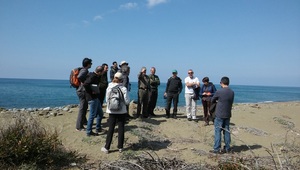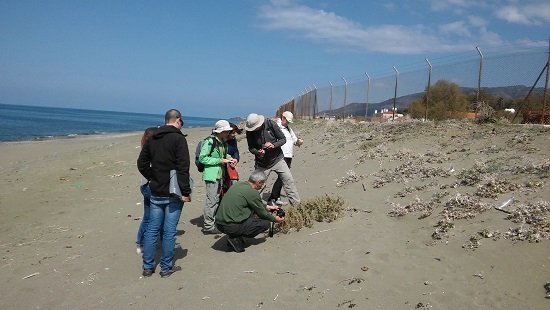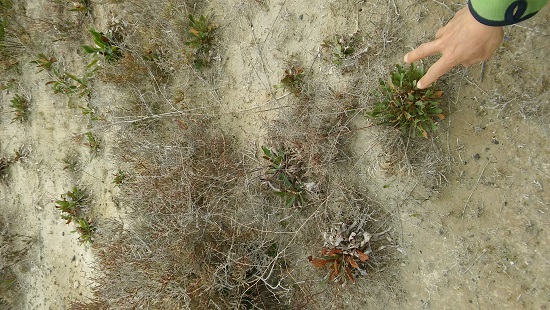Conservation Actions for Threatened Mediterranean Island Flora: ex situ and in situ joint actions
The CARE-MEDIFLORA team meet in Cyprus
25 May 2017

The CARE-MEDIFLORA team met in Cyprus, 7-9 March 2017, for the 2nd project meeting and field trips. The trips took place on 7 and 9 March with destinations in the regions of South-Western and South Eastern Cyprus, respectively. The day in between was devoted to discussions on the progress of CARE-MEDIFLORA.
7 March 2017
The field trip started from the coastal area of Timi village very close to Pafos airport. The species of interest was Anthemis tomentosa. The species occurs in Cyprus, Greece and south west of Turkey. In Cyprus, it is recorded in four locations, the first at Timi coast near Pafos airport (largest subpopulation, about 1500 individuals), the second at Kato Pafos (Natura 2000 site) and two at Kormakitis and Agia Irini coasts, in the Turkish occupies area. It grows on sandy and gravelly coasts (habitat type 2110 Embryonic shifting dunes), near the sea level. Populations in Timi and Kato Pafos, and in particular the one at Timi, are affected by the heavy use of the coast. It was classified as “Endangered” in the Red Data Book of the Flora of Cyprus. CARE-MEDIFLORA team was informed about the in situ conservation actions for Anthemis tometosa. These actions include collection of seeds from Timi, Kato Pafos, production of plants and translocation to new sites (Gialia and/or Akamas), control of invasive species “Acacia saligna”, and establishment of restriction barriers for traffic control.
The second area visited on the same day was Gialia, a village on the northwest coast of the island close to the Akamas peninsula. The taxa of interest in this area were Maresia nana var. glabra, Anthesmis tomentosa and Euphorbia paralias. Maresia nana var. glabra is an endemic taxon and it is classified as “Critical Endangered” in the Red Data Book of the Flora of Cyprus. The taxon occurs only at Gialia area, on the sandy coast within state forest land, which is a designated NATURA 2000 site. The overall population is estimated to 80 plants. The taxon is threatened by habitat loss due to invasion of Acacia saligna and by clearance works on the beach. Its population has declined over the past 10 years. The actions foreseen for this taxon are population reinforcement and control of the invasive species Acacia saligna.
In the same area, translocation actions are planned for Euphorbia paralias and possibly Anthemis tometosa . Euphorbia paralias is widely distributed along coastal areas in the western Europe, the Mediterranean and the Black sea. In Cyprus, it has been recorded at 11 locations, on sandy beaches. The total population is estimated to 3,100 plants. The largest subpopulations are found between Agia Eirini and Kormakitis (1,920 plants) but in most cases they number only 3-50 plants at each location. The taxon is threatened by tourism development, especially, mechanical clearance of sandy beaches and trampling. It was classified as “Endangered” in the Red Data Book of the Flora of Cyprus. Seedlings of Euphorbia paralias, originating from Ayia Napa, will be transplanted at Gialia. The seedlings at Ayia Napa grow on one of the most popular touristic beaches of the island and they will be destroyed during the next summer season.

Gialia area: In situ actions for Maresia nana var. glabra, Anthesmis tomentosa and Euphorbia paralias
9 March 2017
The CARE-MEDIFLORA team visited the south and south-east coastal areas of Cyprus. The first stop was at Larkanka Salt Lake, close to the city of Larnaka and next to the airport. The species of interest was Limonium mucronulatum. The taxon is endemic to Cyprus and was classified as “Critical Endangered” in the Red Data Book of the Flora of Cyprus. The taxon occurs only at Larnaka salt lake, and the overall population is estimated to 700 plants. It grows on the margins of the salt lake, in openings of halophytic scrub near sea level. The population is threatened mainly by uncontrolled (vehicle) traffic through its habitat. The in situ actions for this taxon include population reinforcement by the creation of the appropriate habitat (elevated small hills), control of invasive species (Acacia saligna and Phragmites australis) and soft fencing.
The second and third stops were at Potamos Liopetriou and at Gavo Greko respectively, both are coastal areas in the southeast part of the island . The team had the opportunity to be informed about the in situ conservation actions of Astragalus suberosus. The species occurs in the near east, the east Mediterranean and the Balkans. In Cyprus, it is known from five locations: Agia Thekla (about 1,000 plants), Agia Napa (200 plants), Geri-Latsia (30 plants), Strovolos (10 plants) and south of Geri (5 plants). It occurs in cultivated fields and fallow land, sandy coasts and sparse phrygana, at altitude 0-200 m. It is classified as “Endangered” in the Red Data Book of the Flora of Cyprus. The taxon is threatened by expansion of built-up areas and tourism development at Agia Napa. The largest population of the taxon, at Agia Thekla, has largely been destroyed by the construction of a new marina. Seeds from this site were collected last year, before the beginning of the construction works, and are used for the translocation of the taxon at Potamos Liopetriou and Gavo Gkreko . Around 200 seeds were planted at each site.

Limonium mucronulatum at Alyki Larnacas








